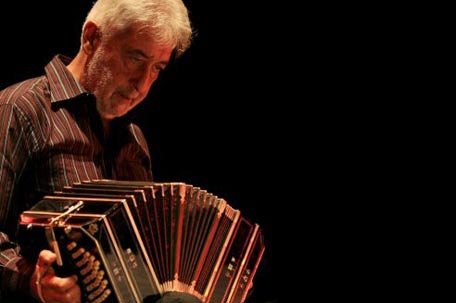

| Carsten Heveling |
| Bando-Aspekte Bandoneon aspects aspectos aspects aspetti |
... zurück back volver retour indietro |
| 142-tönig und Tango Das Bandoneon als vollständiges Instrument in der Musik heute |
142-note and tango music The Bandoneon in the music of today |
||||
| Das 142-tönige Bandoneon ist durchgängig chromatisch vom C bis a'''. Das bedeutet, daß wie auf dem Klavier jeder Ton vom tiefen C bis zum höchsten a''' vorhanden ist. Bekannt ist das 142-tönige Bandoneon vom Argentinischen Tango, man kann jedoch selbstverständlich jede Musik auf dem Bandoneon spielen. Umgekehrt kann man selbstverständlich auch Tango mit anderen Griffweisen wie dem 144-tönigen Einheitsbandonion oder den verschiedenen gleichtönigen Griffweisen spielen. Typisch für den Tango ist der oktavtönige Klang des Bandoneons. Der Klang im klassischen Argentinischen Tango ist auch durch teils unübliche Akkordumkehrungen geprägt. Diese rühren nach meiner Erfahrung eben von der typischen Anordnung der Knöpfe beim 142-tönigen "Tango-Bandoneon". Wenn diese "Tango-Akkorde" beim 142-tönigen bequem liegen, so sind sie trotzdem auch auf jedem anderen Bandoneontyp spielbar. Überhaupt finde ich den Zusammenhang von Musikentwicklung und den technischen Begebenheiten der typischen Instrumente ihrer Zeit spannend. Die Entwicklung der rhythmischen Akzentuierung im Argentinischen Tango erklärt sich für mich aus der Bauart des Bandoneons, das eben klein und auf den Oberschenkeln gespielt, scharfe Akzentuierungen anbietet. Das Akkordeon ist hoch gebaut und bietet ein anderes Spiel an. So haben wir quirligste Läufe in der Französischen Musette-Musik und oft Schlagwerk notwendig beim Europäischem Tango. Auch die unaufgeregte Weichheit der Renaissance- und Barock-Musik hin zur Romantischen und modernen Musik ist interessant anhand seiner typischen Instrumente zu betrachten. Zum Beispiel wurden Streichinstrumente aus dem Barock durch einen massiven Umbau angepaßt oder "verbessert". Ein neuer Hals mit einem Griffbrett in einem steileren Winkel erhöhte mit einem höheren Steg den Druck der Saiten auf das Instrument. Mit modernen Stahlsaiten, in der Geschichte waren es Darmsaiten, haben die Geigen von Stradivari heute keine der eigentlich wesentlichen Originaleigenschaften mehr. Der Hang hin zu Lautstärke und "Brillanz" ist auch in der technischen Entwicklung des Pianos gut zu sehen. Mit Eisengußrahmen und härteren Saiten konnte die Spannung und somit die Laustärke in Klavierbau stetig erhöht werden. Parallel zu dieser Entwicklung stieg auch die Kammertonfrequenz stetig an. So lag die Musik am Hofe von Ludwig XV. im Vergleich zu heute einen ganzen Ton tiefer, Beethovens Musik einen halben Ton tiefer. Aber das ist ein anderes bemerkenswertes Thema.
|
 Juan José Mosalini (1943-2022) ... hier Bilder der Restaurierung des Instruments von J.J.Mosalini ... see photos of the restoration of the Mosalini Bandoneon 142-note and tango music The Bandoneon as a complete instrument for every conceivable music. The 142-tone Bandoneon is consistently chromatic from C to a'''. This means that, as on the piano, every note from the low C to the highest a''' is present. Well known is the 142-tone Bandoneon from Argentine Tango, but of course you can play any music on the Bandoneon. Conversely, of course, you can also play tango with other keyboard layouts such as the 144-note "German Einheitsandoneon" or the various unisonoric keyboard layouts. Typical for the tango is the octave sound of the Bandoneon. The sound in the classical Argentine Tango is also characterized by some unusual chord reversals. These are based in my experience just by the typical arrangement of the buttons in the 142-tone "Tango Bandoneon". If these "tango chords" are comfortable with the 142-note keyboard layout, they can still be played on any other Bandoneon type. In general, I find the connection between music development and the technical details of the typical instruments of her time exciting. The development of the rhythmic accentuation in Argentine Tango is explained to me by the design of the Bandoneon, which is small and played on the thighs. This design offers a play with sharp accents. The Accordion is tall and offers a different use. So we have most virtuosic variations in the French musette music and often drums necessary at the european tango. Even the unruffled softness of Renaissance and Baroque music towards Romantic and modern music is interesting to look at with its typical instruments. For example, baroque string instruments have been adapted or "improved" by a massive remodeling. A new neck with a fingerboard at a steeper angle increased the pressure of the strings on the instrument with a higher bridge. With modern steel strings, in the history of gut strings, the violins of Stradivari today have none of the original essential sound characteristics. The tendency towards volume and "brilliance" is also evident in the technical development of the piano. With iron cast frames and harder strings, the tension and thus the volume in piano could be increased steadily. Parallel to this development, the standard pitch also rose steadily. So the music at the court of Louis XV. was a whole tone lower in comparison to today, Beethoven's music half a tone lower. But that's another notable topic.
|
| © 1998-adhuc BANDO BANDO Wuppertal | |
| Kontakt / Impressum Datenschutzhinweis & Hinweise zur Nutzung |